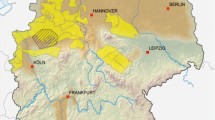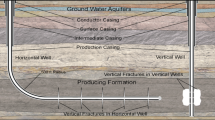Abstract
Hydraulic fracturing of unconventional gas reservoirs rapidly developed especially in the USA to an industrial scale during the last decade. Potential adverse effects such as the deterioration of the quality of exploitable groundwater resources, areal footprints, or even the climate impact were not assessed. Because hydraulic fracturing has already been practised for a long time also in conventional reservoirs, the expansion into the unconventional domain was considered to be just a minor but not a technological step, with potential environmental risks. Thus, safety and environmental protection regulations were not critically developed or refined. Consequently, virtually no baseline conditions were documented before on-site applications as proof of evidence for the net effect of environmental impacts. Not only growing concerns in the general public, but also in the administrations in Germany promoted the commissioning of several expert opinions, evaluating safety, potential risks, and footprints of the technology in focus. The first two publications of the workgroup “Risks in the Geological System” of the independent “Information and Dialogue process on hydraulic fracturing” (commissioned by ExxonMobil Production Deutschland GmbH) comprises the strategy and approaches to identify and assess the potential risks of groundwater contamination of the exploitable groundwater system in the context of hydraulic fracturing operations in the Münsterland cretaceous basin and the Lower Saxony Basin, Germany. While being specific with respect to local geology and the estimation of effective hydraulic parameters, generalized concepts for the contamination risk assessment were developed. The work focuses on barrier effectiveness of different units of the overburden with respect to the migration of fracking fluids and methane, and considers fault zones as potential fluid pathway structures.





Similar content being viewed by others
References
Appel D, Habler W (2002) Quantifizierung der Wasserundurchlässigkeit von Gesteinen als Voraussetzung für die Entwicklung von Kriterien zur Grundwasserbewegung, Phase 2: Auswertung der Datensätze für die Kriterienentwicklung, Bericht zum Arbeitskreis Auswahlverfahren Endlagerstandorte (AkEnd). Hannover (zitiert in Larue J (2010))
Baltes B (ed) (1998) Gesellschaft für Anlagen- und Reaktorsicherheit (GRS) mbH. Entwicklung und Anwendung analytischer Methoden zur Eignungsuntersuchung der Verbringung bergbaufremder Rückstände in dauerhaft offene Grubenräume im Festgestein. Abschlußbericht (Hauptband). GRS
Bornemann O, Behlau J, Fischbeck R, Hammer J, Jaritz W, Keller S, Mingerzahn G, Schramm M (2008) Standortbeschreibung Gorleben, Teil 3: Ergebnisse der über- und untertägigen Erkundung des Salinars—Geologisches Jahrbuch, Reihe C, Band C, Hannover 73:211
Brace WF (1980) Permeability of crystalline and argillaceous rocks. Int J Rock Mech Min Sci Geomech Abstr 17:241–251
Bundesamt für Strahlenschutz (2009) Stilllegung ERA Morsleben: Plan zur Stilllegung des Endlagers für radioaktive Abfälle Morsleben
Croisé J, Schlickenrieder L, Marschall P, Boisson JY, Vogel P, Yamamoto S (2003) Hydrogeological investigations in a low permeability claystone formation: the Mont Terri Rock laboratory. Phys Chem Earth 29(2004):3–15
Delakowitz B (1996) Bestimmung von Grundwassergeschwindigkeit und -richtung mittels radio hydrometrischer Methode.- Planfeststellungsverfahren zur Stilllegung des Endlagers für radioaktive Abfälle Morsleben. Verfahrensunterlage (BfS)
Drozdzewski G (1988) Die Wurzel der Osning-Überschiebung und der Mechanismus herzynischer Inversionsstörungen in Mitteleuropa. Geologische Rundschau 77:127–141
Ewen C, Borchhardt D, Richter S, Hammerbacher R (2012) Hydrofracking risk assessment—executive summary. http://dialog-erdgasundfrac.de/risikostudie-fracking
Fisher K, Warpinski N (2011) Hydraulic fracture-height growth: real data. Soc Petrol Eng SPE 145949
Gautschi A (2001) Hydrogeology of a fractured shale (Opalinus Clay): implications for deep geological disposal of radioactive wastes. Hydrogeol J 9:97–107
Geologischer Dienst Nordrhein-Westfalen (1981) Hydrogeologische Karte von Nordrhein- Westfalen 1:50 000, Sheet L3908 Ahaus, Maps and explanations
Geologischer Dienst Nordrhein-Westfalen (1997) Hydrogeologische Karte von Nordrhein- Westfalen 1:50 000, Sheet L3910 Steinfurt, Maps and explanations
Geologischer Dienst Nordrhein-Westfalen (2006) Hydrogeologische Karte von Nordrhein- Westfalen 1:50 000, Sheet L3914 Bad Iburg, Maps and explanations
Goens J (2011) Hydrogeologische Aspekte des Fracking an der Bohrung Damme 3.Landesamt für Bergbau, Energie und Geologie (LBEG). Präsentation, Hannover. http://www.lbeg.niedersachsen.de/portal/live.php?navigation_id=27762&article_id=93966&_psmand=4. Accessed 26 Jan 2011
Gordalla B, Ewers U, Frimmel FH (2013) Hydraulic fracturing—a toxicological threat for groundwater and drinking water? Environ Earth Sci. doi:10.1007/s12665-013-2672-9
Grobe M, Machel H (2002) Saline groundwater in the Münsterland Cretaceous Basin, Germany: clues to its origin and evolution. Mar Petrol Geol 19:307–322
Grobe M, Machel H, Heuser H (2000) Origin and evolution of saline groundwater in the Münsterland Cretaceous Basin, Germany: oxygen, hydrogen, and strontium isotope evidence. J Geochem Explor 69–70:5–9
Hahn J (1991) Grundwasser in Niedersachsen. Veröffentlichungen der Niedersächsischen Akademie für Geowissenschaften 7:13–27
Hekel U (1994) Hydrogeologische Erkundung toniger Festgesteine am Beispiel des Opalinustons (Unteres Aalenium). TGA, C18:170
Hübner A, Horsfield B, Kapp I (2013) Fact-based communication about shale gas: the Shale Gas Information Platform SHIP. Environ Earth Sci. doi:10.1007/s12665-013-2504-y
Huenges E, Hoth P, Seibt A (1997) In: Kellner T (ed) Geowissenschaftliche Bewertungsgrundlagen zur Nutzung hydrogeothermaler Ressourcen in Norddeutschland. Scientific Technical Report, STR97/15 und Geothermie-Report; 97-1, Geoforschungszentrum, Potsdam, p 149
Huyssen A (1855) Die Soolquellen des Westfälischen Kreidegebirges, ihr Vorkommen und muthmaaslicher Ursprung. Zeitschrift der deutschen geologischen Gesellschaft 7(1):17–252
Jang J, Narsilio GA, Santamarina JC (2011) Hydraulic conductivity in spatially varying media—a pore-scale investigation. Geophys J Int 184(3):1167–1179
Jolley SJ, Dijk H, Lamens JH, Fisher QJ, Manzocchi T, Eikmans H, Huang Y (2007) Faulting and fault sealing in production simulation models; Brent Province, northern North Sea. Petrol Geosci 13(4):321–340
Keferstein CH (ed) (1823) Teutschland, geognostisch-geologisch dargestellt und mit Charten und Durchschnittszeichnungen erläutert. Verlag des Landes-Industrie-Comptoirs, Weimar, 2,3 p 512
Kissinger A, Helmig R, Ebigbo A, Class H, Lange T, Sauter M, Heitfeld M, Klünker J, Wiebke J (2013) Hydraulic fracturing in unconventional gas reservoirs—Risks in the geological system, Part 1. Environ Earth Sci. doi:10.1007/s12665-013-2578-6
Klinge H (1991) Zur Salinität der Tiefenwässer Norddeutschlands. BGR-Bericht 108262, Hannover, p 52
Langkutsch U, Käbel H, Margane A, Schwamm G (1998) Projekt ERA Morsleben. Hydrogeologische Standortbeschreibung und Modellgrundlagen. Planfeststellungsverfahren zur Stilllegung des Endlagers für radioaktive Abfälle Morsleben. Verfahrensunterlage, 3 Teile. (Bundesamt für Strahlenschutz BfS)
Lbeg (1991) Landesamt für Bergbau, Energie und Geologie, Hannover Geowissenschaftliche Karte des Naturraumpotentials von Niedersachsen und Bremen 1:300.000. Hannover
Lbeg (2012) Landesamt für Bergbau, Energie und Geologie, Hannover NIBIS® Kartenserver: Hydrogeologische Übersichtskarten 1:200.000: Versalzung des Grundwassers; Salzstrukturen Norddeutschlands 1:500.000. Hannover (http://nibis.lbeg.de/cardomap3)
Melchers C (2008) Methan im südlichen Münsterland Genese, Migration und Gefahrenpotential. Dissertation, Westfälische Wilhelmsuniversität Münster, p 198
Michel G (1983) Die Sole des Münsterländer Kreide-Beckens. Neues Jb Geol Paläontol Abh 166(1):139–159
Michel G, Struckmeier W (1985) The cretaceous basin of Münster: a general roundwater system in response to multiple impacts (water supply, spas, deep mining). In: Mem. of 18th Congress of International Association of hydrogeologists, S. 4 Abb., 3 Tab., 12 Anh., Cambridge, pp 150–159
NAGRA (2008) Nationale Genossenschaft für die Lagerung radioaktiver Abfälle Technischer Bericht NTB 08-04: Vorschlag geologischer Standortgebiete für das SMA- und das HAA-Lager, Geologische Grundlagen, Textband. Wettingen
Neuzil CE (1994) How permeable are clays and shales? Water Resour Res 30(8):145–150
Olsson O, Weichgrebe D, Rosenwinkel K-H (2013) Hydraulic fracturing wastewater in Germany: composition, treatment, concerns. Environ Earth Sci. doi:10.1007/s12665-013-2535-4
Osborn SG, Vengosh A, Warner NR, Jackson RB (2011) Methane contamination of drinking water accompanying gas-well drilling and hydraulic fracturing. In: Proceedings of the National Academy of Sciences. www.pnas.org/cgi/doi/10.1073/pnas.1100682108, p 5
Reutter E (2011) Hydrostratigrafische Gliederung Niedersachsens.- Geofakten 21, 11 S., 5 Abb., 2 Tab.; Landesamt für Bergbau, Energie und Geologie - LBEG, Hannover
Riedl J, Rotter S, Faetsch S, Schmitt-Jansen M, Altenburger R (2013) Proposal for applying a component-based mixture approach for ecotoxicological assessment of fracturing fluids. Environ Earth Sci. doi:10.1007/s12665-013-2320-4
Röttgen KP (2004) Kritische Analyse des Aufwandes zur Erkundung von Kontaminationen in niedersächsischen Grundwassergeringleitern. TGA, C78:84p
Rudolph T, Melchers C, Coldewey WG (2008) Subsurface permeabilities in the German mining district. Glückauf 144(12):681–690
Satter AG, Igbal M, Buchwalter JL (2008) Practical enhanced reservoir engineering: assisted with simulation software. PennWell Corp., Tulsa, Oklahoma, p 706
Sauter M, Helmig R, Schetelig K, Brosig K, Kissinger A, Lange T, Heitfeld M, Klünker J, Janke W, Ebigbo A, Paape B (2012) Gutachten zur Abschätzung der Auswirkungen von Fracking-Maßnahmen auf das oberflächennahe Grundwasser—Generische Charakterisierung und Modellierung. http://dialog-erdgasundfrac.de/gutachten, p 122
Streif H, Caspers G, Freund H, Geyh M A, Kleinmann A, Merkt J, Meyer K-D, Müller H, Rohde P, Schwarz C (2007) Das Quartär in Niedersachsen und benachbarten Gebieten—Gliederung, geologische Prozesse, Ablagerungen und Landschaftsformen. http://www.lgb-rlp.de/fileadmin/extern/stratigraphie/nd/litho/quart/quart_gesamt.pdf
Strobel M, Wisotzky F (2009) Einfluss von Methaneinträgen auf die Hydrochemie des Münsterländer Kiessandzuges. Grundwasser 14(1):33–45
Struckmeier W (1990) Wasserhaushalt und Hydrologische Systemanalyse des Münterländer Beckens. LWA (Landesamt für Wasser und Abfall Nordrhein-Westfalen) Schriftenreihe 45:71
Thielemann T (2000) Der Methanhaushalt über kohleführenden Sedimentbecken. Das Ruhrbecken und die Niederrheinische Bucht. Jülich
Uth H-J (2012) Gutachten zur Technische Sicherheit von Anlagen und Verfahren zur Erkundung und Förderung von Erdgas aus nichtkonventionellen Lagerstätten. http://dialog-erdgasundfrac.de/gutachten, p 113
Voigt S, Aurag A, Leis F, Kaplan U (2007) Late Cenomanian to Middle Turonian highresolution carbon isotope stratigraphy: new data from the Münsterland Cretaceous Basin Germany. Earth Planet Sci Lett 253:196–210
Wedewardt M (1995) Hydrochemie und Genese der Tiefenwässer im Ruhr-Revier. DMT Berichte aus Forschung und Entwicklung 39:250
Acknowledgments
The authors would like to thank Christoph Ewen and Ruth Hammerbacher along with their teams for the conceptual development and organisation of the hydrofracking dialogue and information dissemination processes. The authors would also like to express their sincere thanks to Michael A. Celia, Avner Vengosh and David Yoxtheimer for reviewing the work of the group “Risks in the Geological System”. In addition, important improvements with respect to readability and clarity were achieved by the valuable comments made by the reviewers of this paper.
Author information
Authors and Affiliations
Corresponding author
Rights and permissions
About this article
Cite this article
Lange, T., Sauter, M., Heitfeld, M. et al. Hydraulic fracturing in unconventional gas reservoirs: risks in the geological system part 1. Environ Earth Sci 70, 3839–3853 (2013). https://doi.org/10.1007/s12665-013-2803-3
Received:
Accepted:
Published:
Issue Date:
DOI: https://doi.org/10.1007/s12665-013-2803-3




